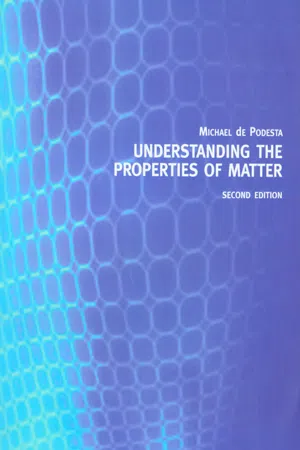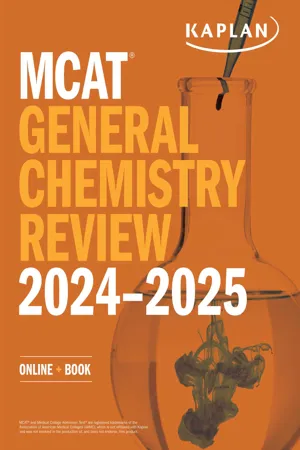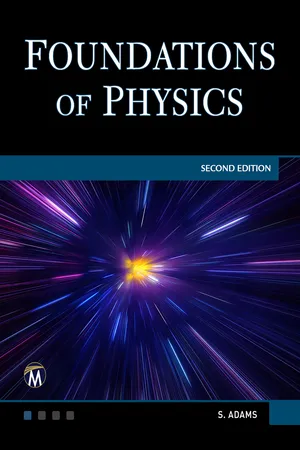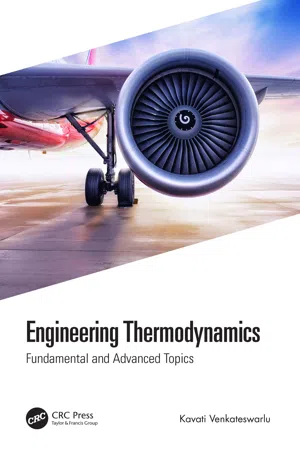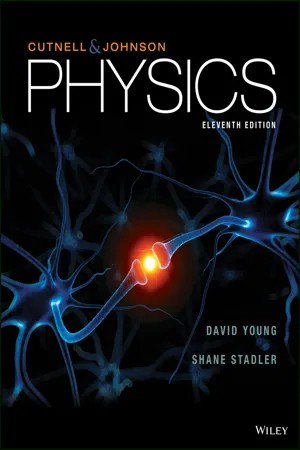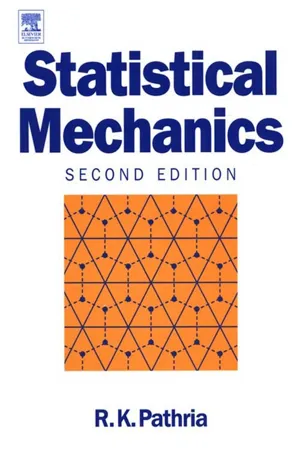Physics
Ideal Gas Model
The ideal gas model is a theoretical concept used to describe the behavior of gases under certain conditions. It assumes that gas particles have negligible volume and do not interact with each other, and that their kinetic energy is directly proportional to the temperature. This model is often used to simplify calculations and understand the basic properties of gases.
Written by Perlego with AI-assistance
Related key terms
Related key terms
1 of 4
Related key terms
1 of 3
8 Key excerpts on "Ideal Gas Model"
- eBook - ePub
- Michael de Podesta(Author)
- 2020(Publication Date)
- CRC Press(Publisher)
Chapter 5 , we have every reason to believe these predictions because quantitative explanations of the properties of gases based on the Ideal Gas Model are extraordinarily successful.§4.2 The Ideal Gas Model: Here we outline the basic assumptions of the ideal gas theory. Importantly these assumptions are approximately true for almost every real gas that we will encounter! Then we derive from first principles an equation that relates the density of an ideal gas to its temperature and pressure§4.3 Calculating microscopic quantities: In this section we look at some results which allow us to calculate some microscopic properties of gas.§4.4 Beyond the ideal gas equation: Finally we look at how we can extend the ideal gas theory in order to take account of a more realistic set of assumptions than those we made in §4.2.4.2 The Ideal Gas Model
4.2.1 Assumptions
The simplest model of a real gas is known as the ideal or perfect model of a gas. It consists of a list of real properties of molecules that are systematically ignored! The justification for this is that the model is relatively simple and yet has wide range of applicability. It predicts an astoundingly simple expression for the macroscopic properties of any gas, independent of the type of molecules that make up the gas. This universal relationship is summarised in the so-called ideal gas equation:
whereP V = z R T(4.1) P is the pressure of the gas (Pa)Vis the volume of the gas (m 3)zis the number of moles of the gas under consideration (mol) .T is the absolute temperature (K)Ris the molar gas constant (J K− 1mol)− 1What we assume:What we neglect:The molecules behave as perfect point masses, i.e. they have zero volume. - No longer available |Learn more
MCAT General Chemistry Review 2024-2025
Online + Book
- (Author)
- 2023(Publication Date)
- Kaplan Test Prep(Publisher)
real gases deviate from this ideal behavior at high pressures (low volumes) and low temperatures, many compressed real gases demonstrate behavior that is close to ideal.KEY CONCEPT
An ideal gas follows the gas laws we will discuss at all pressures and temperatures. A real gas deviates from these laws at high pressures (low volumes) and low temperatures because of intermolecular forces or volume effects.Ideal Gas Law
The ideal gas law was first stated in 1834 by Benoît Paul Émile Clapeyron, more than 170 years after Sir Robert Boyle performed his experimental studies on the relationship between pressure and volume in the gas state. In fact, by the time the ideal gas law found its expression, Boyle’s law, Charles’s law, and Dalton’s law had already been well-established. Historical considerations aside, it will benefit us to examine the ideal gas law first so that we can then understand the other laws, which had been identified earlier, to be only special cases of the ideal gas law.The ideal gas law shows the relationship among four variables that define a sample of gas:PV = nRTEquation 8.1where P is the pressure, V is the volume, n is the number of moles, and T is the temperature. R represents the ideal gas constant, which has a value ofBe aware that the gas constant can be expressed in other units. On the MCAT, you may also encounter R given as8.21 ×10− 2.L · atmmol · Kwhich is derived when SI units of pascal (for pressure) and cubic meters (for volume) are substituted into the ideal gas law. Although the relevant values for R will be provided on Test Day if needed, it is important to recognize the appropriate value for R based on the units of the variables given in a passage or question stem.8.314J,K · molThe ideal gas law is used to determine the missing term when given all of the others. It can also be used to calculate the change in a term while holding two of the others constant. It is most commonly used to solve for volume or pressure at any given temperature and number of moles; Figure 8.2 - eBook - ePub
- Steve Adams(Author)
- 2023(Publication Date)
- Mercury Learning and Information(Publisher)
1 . The ideal gas equation is often written in the form:Equation of state for an ideal gas: pV = nRTWhere n is the number of moles.9.3 THE KINETIC THEORY OF GASES9.3.1 Assumptions of the Kinetic TheoryThe gas laws are based on experiments but can be explained using Newton’s laws if we make a few assumptions about the microscopic nature of a gas. The key assumptions of kinetic theory are:Gases consist of a large number of tiny, massive particles in rapid random motion.The particles have no long-range interactions.All collisions are elastic.The volume occupied by the particles themselves is negligible.Kinetic theory was developed by Boltzmann and others in the 19th century and its great success provided strong support for the idea that matter really is composed of tiny massive particles (the atomic theory). However, even as late as 1900, some physicists and philosophers opposed this theory and suggested that it was simply a convenient model and did not correspond to physical reality. The most convincing evidence that atomic theory was correct came from Einstein’s analysis of Brownian motion in 1905.9.3.2 Explaining Gas PressureGas molecules inside a container are continually colliding with the walls of the container and rebounding. In each collision the wall exerts a force on the molecule that changes its direction so, by Newton’s third law, the molecule exerts an equal but opposite force on the wall. The net effect of billions of collisions creates an almost constant outward force on the wall. Pressure is force per unit area and force is equal to the rate of change of momentum, so the pressure exerted by a gas is equal to the average rate of change of molecular momentum per unit area.We will build up an expression for gas pressure by considering first a single molecule bouncing backward and forward in a box, and then adding more molecules and allowing them to have random speeds and directions. Let’s start with one molecule of mass m moving in the positive x -direction and colliding with the wall of a cubic container of side a - eBook - ePub
Engineering Thermodynamics
Fundamental and Advanced Topics
- Kavati Venkateswarlu(Author)
- 2020(Publication Date)
- CRC Press(Publisher)
8 Properties of Gases and Gas MixturesLearning Outcomes After learning this chapter, students should be able to- Explain the quantitative relationship between T, v, and P as described by the kinetic theory of gases and Ideal Gas Models.
- Interpret the relationship between partial pressures and the total pressure as described in Dalton’s law of partial pressure.
- Determine the mole fractions of gases within and gas mixture and relate mole fraction to the partial pressure of a gas within a gas mixture.
- Explain the relationship between kinetic energy and temperature of a gas; between temperature and the velocity of a gas; and between molar mass and the velocity of a gas.
- Explain the deviation of Ideal Gas Models with the behavior of real gases observed in nature.
- Explain the general principles of the hard-sphere model and the Van der Waals model of gas.
8.1 Ideal Gas Equation of State
Equation of State
It is defined as the functional relationship among the properties pressure p, specific volume ν, and temperature T, expressed as f(p,ν,T) = 0. The equation of state is useful for finding the properties of a gas; that is, if two of the properties are known, the third can be found. There are numerous equations of state, including simple and complex ones. The ideal gas equation of state is comparatively simple and it can accurately predict the behavior of substances in the gas phase.Robert Boyle proved experimentally that the pressure of gases is inversely proportional to their volume. Charles and Gay Lussac showed that the volume of a gas is directly proportional to its temperature at low pressures, which is expressed aswhich is an ideal gas equation of state. R is a characteristic gas constant; its value is different for different gases.p ν = RT(8.1) - eBook - ePub
Chemistry
With Inorganic Qualitative Analysis
- Therald Moeller(Author)
- 2012(Publication Date)
- Academic Press(Publisher)
total energy of the molecules that have collided is the same after the collision as it was before. If this were not so, gas molecules would gradually lose energy, slow down, and eventually come to a halt, just as a bouncing tennis ball does. We can see that this does not happen. Gas molecules do not eventually collect at the bottom of a container, the atmosphere remains suspended in the Earth’s gravitational field, and the pressure in a leak-free container of gas does not decrease, no matter how long the container stands.3.5 Ideal vs. real gases
The kinetic-molecular theory provides a model of how gases ideally behave-the molecules are point masses with negligible volume and move in random straight-line paths. No forces of attraction or repulsion are exerted between the molecules or between the molecules and their surroundings, and the molecules bounce off of each other or the walls of their container with no loss of kinetic energy. Experimentally and in mathematical theory, molecules with all of these properties would exactly fulfill the predictions of the gas laws, which you will be learning in later sections of this chapter. A gas that perfectly obeys the gas laws is called an ideal gas .Real gas molecules always have real volume, of course, and they also have forces of attraction and repulsion toward each other. Gas molecules of small mass that are far apart, have behavior that is closest to what theory predicts for an ideal gas. As gases approach liquefaction and the molecules come closer together because of volume and temperature decreases, or pressure increases, deviations from ideality become greater. Deviations from ideality are discussed further at the end of this chapter (Section 3.17 ). In the examples and problems in the following sections, the gases are treated as ideal.Volume, pressure, and temperature relationships
- eBook - ePub
- Louis Theodore, R. Ryan Dupont, Kumar Ganesan(Authors)
- 2017(Publication Date)
- Wiley-Scrivener(Publisher)
These reduced properties have also served as the basis for many equations that are employed in practice to describe non-ideal gas (and liquid) behavior. Although a rigorous treatment of this material is beyond the scope of this book, information is available in the literature [2,3]. Highlights of this topic are presented below. No real gas conforms exactly to the IGL, but it can be used as an excellent approximation for most gases at pressures about or less than 5 atm and near ambient temperatures. One approach to account for the previously mentioned deviations from ideality is to include a correction factor, Z, which is defined as the compressibility coefficient or compressibility factor. The ideal gas law is then modified to the following form: (4.16) Note that Z approaches 1.0 as P approaches 0.0. For an ideal gas, Z is exactly unity. This equation may also be written as: (4.17) where v is now the specific molar volume (not the total volume) with units of volume/mole. Regarding gas mixtures, the ideal gas law can be applied directly for ideal gas mixtures. However, the molecular weight of the mixture is based on a mole fraction average,, of the n components: (4.18) One approach to account for deviations from ideality is to assume the aforementioned compressibility coefficient for the mixture,, is a linear mole fraction combination of the individual component Z values: (4.19) Furthermore, Kay [4] has shown that the deviations arising in using this approach can be reduced by employing pseudocritical values for T and P where: (4.20) (4.21) In lieu of other information, the authors suggest employing Equation 4.22 for the pseudocritical value of v : (4.22) These pseudocritical values – T c, P c, and – are then employed in the appropriate pure component equation of state - eBook - ePub
- John D. Cutnell, Kenneth W. Johnson, David Young, Shane Stadler(Authors)
- 2018(Publication Date)
- Wiley(Publisher)
3 of substance B.3. A gas mixture contains equal masses of the monatomic gases argon (atomic mass = 39.948 u) and neon (atomic mass = 20.179 u). These two are the only gases present. Of the total number of atoms in the mixture, what percentage is neon?14.2 The Ideal Gas Law
An ideal gas is an idealized model for real gases that have sufficiently low densities. The condition of low density means that the molecules of the gas are so far apart that they do not interact (except during collisions that are effectively elastic). The ideal gas law expresses the relationship between the absolute pressure, the Kelvin temperature, the volume, and the number of moles of the gas.In discussing the constant-volume gas thermometer, Section 12.2 has already explained the relationship between the absolute pressure and Kelvin temperature of a low-density gas. This thermometer utilizes a small amount of gas (e.g., hydrogen or helium) placed inside a bulb and kept at a constant volume. Since the density is low, the gas behaves as an ideal gas. Experiment reveals that a plot of gas pressure versus temperature is a straight line, as in Figure 12.4 . This plot is redrawn in Animated Figure 14.3 , with the change that the temperature axis is now labeled in kelvins rather than in degrees Celsius. The graph indicates that the absolute pressure P is directly proportional to the Kelvin temperatureT (P ∝ T), for a fixed volume and a fixed number of molecules.ANIMATED FIGURE 14.3The pressure inside a constant-volume gas thermometer is directly proportional to the Kelvin temperature, a proportionality that is characteristic of an ideal gas.The relation between absolute pressure and the number of molecules of an ideal gas is simple. Experience indicates that it is possible to increase the pressure of a gas by adding more molecules; this is exactly what happens when a tire is pumped up. When the volume and temperature of a low-density gas are kept constant, doubling the number of molecules doubles the pressure. Thus, the absolute pressure of an ideal gas at constant temperature and constant volume is proportional to the number of molecules or, equivalently, to the number of moles n of the gas(P ∝ n - eBook - ePub
- Paul D. Beale(Author)
- 1996(Publication Date)
- Butterworth-Heinemann(Publisher)
CHAPTER 6 THE THEORY OF SIMPLE GASESWE ARE now fully equipped with the formalism required for determining the macroscopic properties of a large variety of physical systems. In most cases, however, derivations run into serious mathematical difficulties, with the result that one is forced to restrict one’s analysis either to simpler kinds of systems or to simplified models of actual systems. In practice, even these restricted studies are carried out in a series of stages, the first stage of the process being highly “idealized”. The best example of such an idealization is the familiar ideal gas, a study of which is not only helpful in acquiring facility with the mathematical procedures but also throws considerable light on the physical behavior of gases actually met with in nature. In fact, it also serves as a base on which the theory of real gases can be founded; see Chapter 9 .In this chapter we propose to derive, and at some length discuss, the most basic properties of simple gaseous systems obeying quantum statistics; the discussion will include some of the essential features of diatomic and polyatomic gases as well.6.1 An ideal gas in a quantum-mechanical microcanonical ensemble
We consider a gaseous system of N non-interacting, indistinguishable particles, confined to a space of volume V and sharing a given energy E . The statistical quantity of interest in this case is Ω(N, V, E ) which, by definition, denotes the number of distinct microstates accessible to the system under the macrostate (N, V, E
Index pages curate the most relevant extracts from our library of academic textbooks. They’ve been created using an in-house natural language model (NLM), each adding context and meaning to key research topics.
Explore more topic indexes
Explore more topic indexes
1 of 6
Explore more topic indexes
1 of 4
